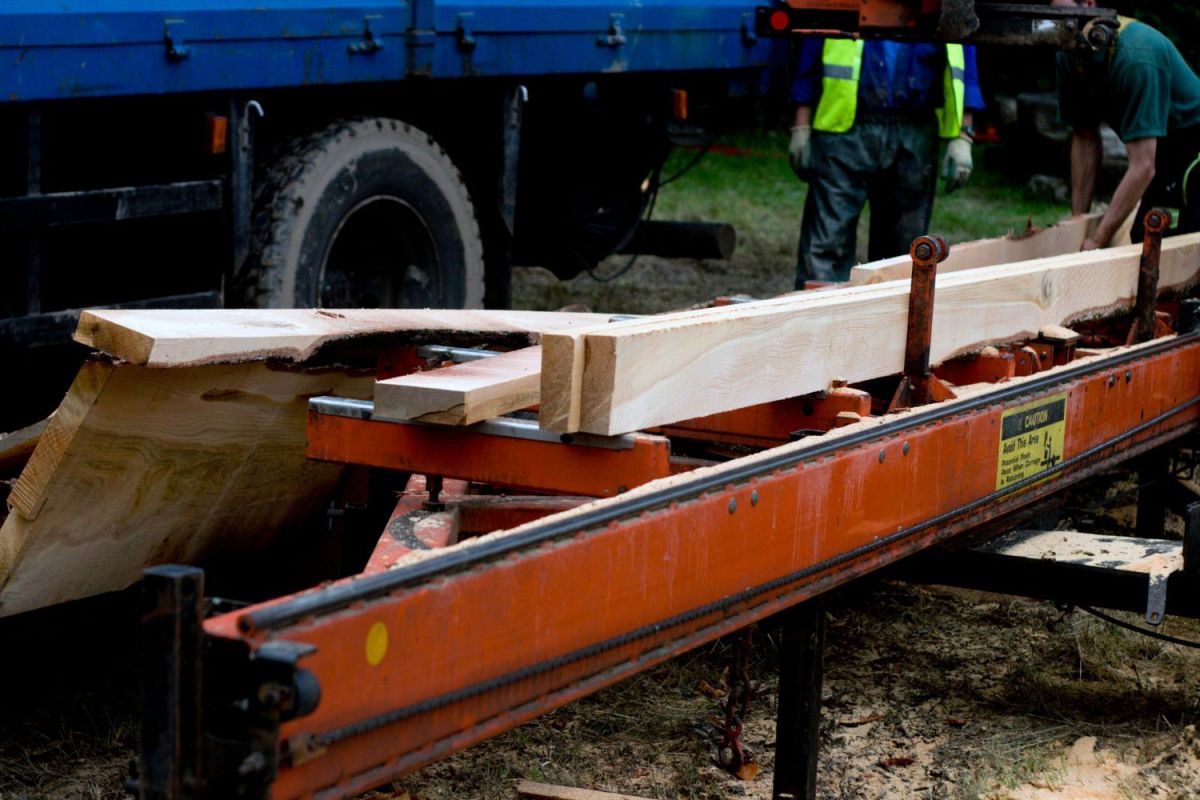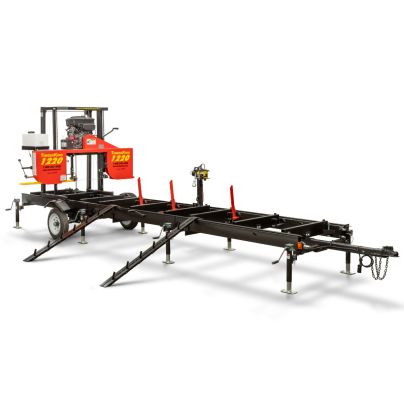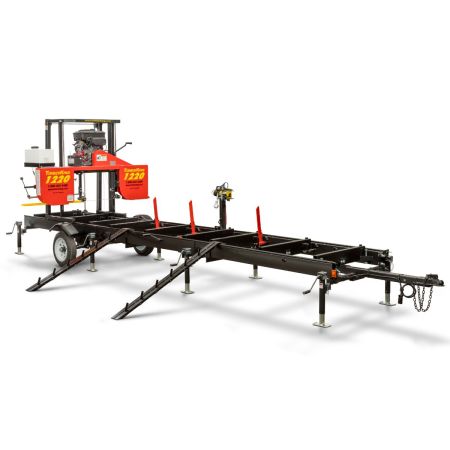We may earn revenue from the products available on this page and participate in affiliate programs. Learn More ›

Sooner or later, homesteaders and folks who regularly convert trees into usable (and valuable) lumber may wish to own a portable sawmill. These devices consist of a track that clamps onto a log, allowing the user to make straight cuts accurately. While chainsaw mills are a cost-effective option for modest-size logs and low production, serious sawing demands a step up in scale.
Fortunately, there are plenty of high-performance machines to choose from and a wide variety of specifications to suit different needs. Those new to these types of sawmills should learn which features provide real value. Our concise look at the best portable sawmills currently available will help buyers find the right solution.
How We Chose the Best Portable Sawmills
I have considerable experience using chainsaws and with small-scale milling, so although these portable wood mills are larger and more powerful, I do have a thorough understanding of the engineering.
To support my own knowledge, the Bob Vila team researched all the leading brands and the specifications of machines they offer. We considered mobility, cutting capacities, and cost. We also compared results from other reputable portable sawmill reviews.
Rather than simply comparing similar tools, we aimed to provide examples of the best portable sawmills at various levels of productivity. In doing so, we’ve discovered products for a range of users, from small homesteaders to full-time logging professionals.
Best Overall
TimberKing 1220CRZ Portable Sawmill
See ItWhen looking into the manufacturer of the best portable sawmill, we found the TimberKing brand consistently ranked highly in independent reviews and on homesteader websites. The company has been making portable sawmills since 1929, and it has an unrivaled reputation for performance and durability.
Unlike cheap portable sawmills that need to be carried to and from a site, the TimberKing 1220CRZ is fully mobile with pneumatic tires and standard vehicle hookup. The immensely strong frame is made from 2×6 box beam steel. It is heavily cross braced to resist the flex under load. The saw head is supported by four posts, further adding to the impressive rigidity that ensures accurate cutting. Saw drive comes from a powerful and very reliable 23-horsepower v-twin motor that has push-button electric starting.
The TimberKing 1220CRZ takes logs up to 33 inches in diameter and over 17 feet long. Board thickness is set with a hand crank, with a depth gauge that allows remarkably precise cutting to 1/32 inch. Feed is also by hand crank. It takes a little practice to produce consistently smooth cuts, and it can be tiring when working all day, but it is far less expensive than hydraulic models.
Product Specs
- Maximum log diameter: 33 inches
- Maximum log length: 17 feet, 9 inches
- Power unit: 23-horsepower V-twin with electric start
Pros
- A 4-post head provides rigid saw support for consistently accurate cutting
- The heavy-duty cutting deck resists flex and offers terrific durability
- The American-made V-twin engine is both powerful and reliable
Cons
- Some assembly is required before the sawmill can be used
- The crank-driven saw head takes a while to master and can be tiring to use
Get the TimberKing portable sawmill at TimberKing.
Other Product Recommendations
The following machines are also excellent and, depending on individual requirements, deserve further investigation.
Best Bang for the Buck: Sawyer Portable Sawmill
With a maximum log diameter of 21 inches, this Sawyer is a small portable sawmill at a budget price. Assembly is required.
Available at Hud-son.
Best Mid-Range: Norwood LumberMate LM30
This model has a maximum log diameter of 30 inches and comes with a wide choice of power units and custom add-ons.
Available at Norwood Sawmills.
Best Hydraulic Loading: Wood-Mizer LT35
Large diameter logs can be very heavy, especially hardwoods like oak. This model makes work easier with hydraulic lifting of logs up to 32 inches across.
Available at Wood-Mizer.
Best Chainsaw Mill: Granberg Alaskan Mark IV
Chainsaw mills remain a budget-friendly option for those with modest needs, and the highly rated Granberg can accept chainsaws with bars of up to 36 inches.
Available at Amazon.
FAQs
Beyond trying to decide on the best portable sawmill for one’s needs, a number of questions associated with machine operation and productivity crop up regularly. The following provides clear, concise answers.
Q. Is it cheaper to mill your own lumber?
There’s no easy answer to this question. Even comparatively cheap portable sawmills demand a significant investment (see below). If you just need a couple dozen 2x4s for a project, it will probably be cost effective to buy them at your local big box DIY store or lumber yard.
On the other hand, if you regularly fell your own trees or have access to a supply of whole logs, owning a portable sawmilling machine can not only save a lot of money over time, but also gives complete control over lumber quality. Buying a used portable sawmill can be a cost-saving option, but expertise is required to assess the condition of these machines. It’s not something we would recommend to novices.
Q. How much does a portable sawmill cost?
The cost of a portable sawmill varies considerably. The above article includes some excellent examples from across much of the price range. High-quality entry-level portable sawmills start at around $2,500 for self-assembly models or somewhere over $3,000 assembled. At the other end of the scale, those with big capacities and hydraulic log lifters can top $50,000.
Q.How long do the blades last on a portable sawmill?
Leading portable sawmill brand Wood-Mizer recommends changing blades for fresh ones every 1½ hours. A random sample of users gave figures of three to six blade changes per day. Much depends on the wood being milled, however. Softwoods like pine saw much more easily than oak, for example.
Running a blade when blunt is false economy, as it’s one of the main causes of blade breakage. Sharpening services are widely available, or you could do it yourself using a jig and a rotary tool.
Q. How long should logs dry before sawing?
Logs should be sawed (milled) as soon as possible after felling. There is no advantage in leaving them on the ground. In fact, doing so might attract beetles and fungi that cause damage. Once milled, lumber requires time to dry properly: The general rule is 1 year per inch of board thickness. Commercial operations often use large drying sheds (called kilns) to speed up the process.
Why Trust Bob Vila
Bob Vila has been America’s Handyman since 1979. As the host of beloved and groundbreaking TV series including “This Old House” and “Bob Vila’s Home Again,” he popularized and became synonymous with “do-it-yourself” home improvement.
Tools and machinery specialist Bob Beacham has been writing consumer advice articles for national publications for more than a decade. He comes from a farming background, is a qualified mechanical engineer, and ran his own woodshop for a decade. He has a reputation for providing information that is thorough yet easy to understand.

